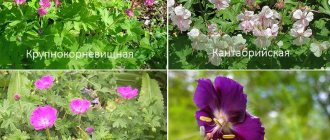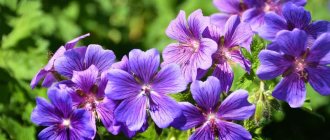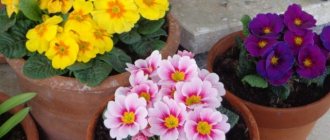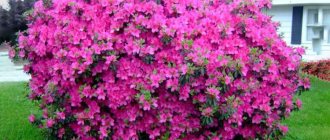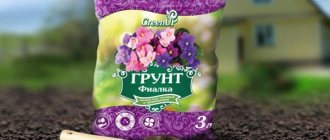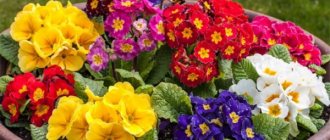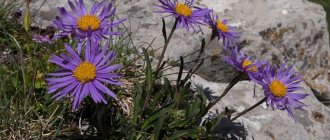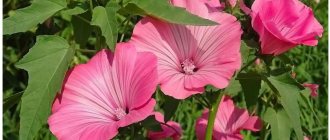Time for planting in pots
Geranium grows very beautifully on balconies, in large pots in the garden; gardeners often use decorative pots with pelargonium for a variety of design solutions. Often several bushes with different colors are planted.
- There are no problems when planting geraniums in decorative pots. In spring, the plant can be planted at a time that is convenient. But provided that the pots can be removed from the street or covered in case of zero temperature. Overgrown pelargonium tolerates cold well, but does not tolerate frost.
- Another important condition for a successful transplant is the absence of flowers on the bushes. Flowering plants take root very poorly, so replanting during this period is best avoided.
- At first, planted and established plants should be taken out into the garden only during the day, and when the danger of freezing passes, you can leave them overnight.
https://youtu.be/https://www.youtube.com/watch?v=OWtUe68WXIE
_
Rules for planting seedlings
If you plant pelargonium from seeds, then you first need to grow the seedlings and only then plant them in open ground. When disembarking, use the following scheme:
At the end of February - beginning of March, we sow the seeds in a container or peat tablets.- When a pair of true leaves appear, we dive into separate pots. Can be planted directly into pots.
- We take care of the seedlings - water them in a timely manner, feed them, keep them in a warm, well-lit place.
- As soon as the last frost period has ended (late May - early June), we plant the seedlings in the chosen location. Geranium, by the way, spends the summer well outside in containers and flower pots.
- It is best to plant the plant in the morning.
How to plant geraniums correctly
Perennial garden geranium quickly develops long roots. Allow the young shoots to take root well and grow undisturbed for the first time: dig a deep hole so that about 20 cm of loose soil remains under the longest root. There should be at least 30 cm between the holes. Before planting, treat the rhizomes with a disinfectant solution and the lower sections of the cuttings with growth stimulants.
Planting is carried out in early spring or autumn. Place a mound of fertile soil at the bottom, install the rhizome and distribute the underground shoots evenly over the soil elevation. Cover with soil and water to compact the soil. The first year there will not be very many leaves; they will not protect the flower garden from weeds. To avoid weeding, mulch the soil. Pelargonium, asters or other annuals can fill the voids.
Bury the cut cuttings into the soil by about 5 cm. Until the shoots take root, they require care. Protect the sprouts from frost with film or non-woven material. Make sure the soil is moist, but the water does not stagnate. In hot weather, all plantings in the first days should be shaded from the scorching rays of the sun.
How to replant?
Geranium feels good in one place for even ten years, but because... prone to strong growth, it is replanted every two years with islands located at a distance of 20-30 cm from each other.
It is better to replant in the spring (you can find out how to replant geraniums at home here). The planting hole must be deep enough so that the branched root system can be located freely. After placing in the hole, the plant must be watered and the soil must be mulched to avoid it drying out.
Planting and care
Geranium feels great in open ground, but its beauty will be fully revealed if you provide the necessary care. First of all, decide on the landing site:
- The plant requires a lot of light, but does not tolerate hot, scorching sun rays, so a bright place, slightly shaded during the midday hours, is best suited.
- The flower easily adapts to light partial shade, almost without losing its flowering splendor. A flowerbed near the house, illuminated only half of the day, or the trunks of an apple tree are also perfect.
- Find out exactly the type and variety of the plant. Modern selection offers both dwarf bushes for borders and quite powerful, up to 70 cm, mid- and long-range plants.
As with many garden plants, you should prepare the soil in advance: remove weeds, dig it up, apply humus or complex fertilizer (it is better to do this at least a month before planting). Geranium does not tolerate stagnant water, so on heavy soils, be sure to place a drainage layer in the planting hole. You will have to dig a big hole: the flower is famous for its powerful, long roots.
Garden geranium is unpretentious
Adding soil, watering and mandatory mulching - numerous leaves actively evaporate moisture. For the same reason, it is worth closely monitoring the flower during the summer: in hot, dry weather, small but regular watering is needed. The plant itself will signal this - the usually straightened and elastic leaves will droop slightly. Geranium will be grateful if you feed it with nitrogen fertilizer in the spring, and potassium-phosphorus supplements will prolong flowering. But even without this, it will delight you with lush greenery and bright flowers. For most varieties, shelter for the winter is not required.
When choosing neighbors to plant together, pay attention to the combination of colors and the architecture of the plants. Geranium is good on its own, but it also harmonizes perfectly with plants with large flowers (roses, peonies, datura), creating an excellent background with abundant carved foliage and small flowers.
Next to decorative deciduous species (hosta, periwinkle, clasp), the flowering bush itself will sparkle with new colors, and proximity to cereals, thyme or catnip will give the flowerbed the appearance of a natural lawn or forest edge.
Growing a flower outside the home?
Pelargonium does not require any supernatural conditions, so caring for it is very simple.
Watering
It's simple - water as the soil dries out. Geranium tolerates drought more easily than waterlogging. Excessive watering leads to fungal diseases. It is better to water in the morning, especially at first.
Feeding
For abundant flowering, the plant will need a lot of strength, so complex mineral fertilizers for flowering plants will be a good help for it. Once every 3-4 weeks. There is no need to specifically apply nitrogen fertilizers. This will provoke active growth of green mass to the detriment of flowering. Such nutrition should be carried out in the soil before planting, preferably even in the fall.
You can learn more about feeding for pelargonium here.
Formation
As a rule, pelargonium has a normal natural shape, so you only need to remove faded umbrellas. If you want a more lush and squat bush, you should pinch the tip of the shoot when planting. What to do when winter is coming? As soon as frost approaches, it’s time to take the pelargonium home. No matter how you cover it, it still won’t survive our winter.
You can find out more about bush formation here.
Planting geraniums in the garden and caring for the crop
The ornamental varieties of garden geranium that exist today are owed to the interest of breeders from Holland and Great Britain in this plant. Despite the fact that these cultivated species have become brighter, their flowering is more abundant and longer, geraniums in the garden require the selection of conditions close to those in which their wild ancestors grew.
When geraniums are planted in open ground in the spring, the planting site is chosen depending on the variety and type:
- Meadow, Himalayan or magnificent outdoor geraniums will actively grow and bloom if the plants are in the sun and given plenty of water.
- In dry corners of the garden, where there is a lot of sun, the large-flowered and red-brown variety is irreplaceable.
- Georgian geranium looks good on an alpine hill.
- If there is a damp corner in the shade of trees at your summer cottage, marsh geranium will grow beautifully here.
- Balkan geranium, when planted and cared for at the dacha, easily tolerates drought and shading.
All geraniums have branched long roots that tolerate transplantation extremely poorly. To reduce the stress of this procedure and simplify subsequent care, a fairly deep planting hole is made for planting geraniums in the garden. Its depth should be several centimeters greater than the length of the roots spread over the nutrient soil at the bottom of the hole. After careful backfilling, the planting site is watered and the soil on top is mulched.
Since most species grow significantly in a couple of years, there should be at least 20–30 cm between individual geraniums in the garden. And yet, even such an unpretentious plant that can stand up for itself needs support. Caring for geraniums in the garden after planting consists of:
- in regular watering that meets the needs of a particular plant type;
- in fertilizing, the first of which, using an infusion of compost and peat, is carried out immediately after transplantation;
- in the autumn pruning of withered foliage and the summer removal of faded inflorescences.
Spring for geraniums should begin with fertilizing with nitrogen fertilizer. It will push the plant to form lush foliage, and after a month a complex product is applied to the plants, which contains nitrogen, phosphorus, potassium and microelements. Species accustomed to living in mountains or arid areas require less fertilizer than lowland varieties.
Perennial garden geranium is an unusual, undemanding and very attractive green decoration for any site. The plant is universal and can be successfully used in single and group plantings without requiring special care.
How to plant correctly?
Before planting geraniums you need to:
- determine the landing time;
- choose a suitable location on the site;
- prepare material (seeds, seedlings or rhizomes);
- equip planting pits.
Watch a video about planting geraniums in open ground:
Time
Garden geraniums are planted in early spring and early autumn. In spring, you can start planting in the first half of May, when the ground warms up to +15-18 °C. After planting, if necessary, cover the plants.
Selecting a location
Soil composition is a general requirement for planting all types of geraniums, because... she does not like clay and loamy soils (read about what kind of soil indoor geraniums like and whether a universal soil is suitable, read here). The land must be fertile and necessarily without stagnant groundwater to avoid root rotting.
Advice! If the soil on the site is clayey, add peat or rotted compost to it.
With the variety of varieties of geraniums, it is not difficult to choose the right type for almost any garden plot. For example:
- if a lot of sun is suitable: meadow (G.pratense), Himalayan grandiflorum (G.himalayense = G.grandiflorum), red-brown (G.phaeum) or magnificent (Gx magnificum);
- in a shaded area - large rhizomatous or otherwise Bulgarian, Balkan (G.macrorrhizum);
- where the wet soil is marsh (G.palustre);
- for alpine hills - Georgian geranium (G.ibericum);
- for flower beds and flower beds - species with taller plants, above 50 cm: red-brown (G.phaeum), meadow (G.pratense);
- for planting along paths - low, up to 50 cm: large rhizomatous or otherwise Bulgarian, Balkan (G.macrorrhizum).
Material
Can be used:
- seeds;
- rhizome;
- seedlings.
The best option would be to purchase seedlings with a closed root system. They are characterized by good survival in the ground.
Planting pits
Adult geraniums have long roots with lateral shoots, and therefore it is important to take this feature into account when making spacious holes.
Requirements:
- the hole should not be shallow (about 20 cm deeper than the length of the roots of the seedling);
- a layer of small stones, broken bricks or gravel should be poured onto the bottom - this is drainage;
- for drainage - a layer of a mixture of peat, sand, rotted compost.
After landing, be sure to:
- water the plant generously;
- mulch the soil - sprinkle with dry peat, compost or bark.
Reference! Geranium is planted in islands (several bushes nearby) at a distance of 20-30 cm between the islands.
We talked about how, when and why to plant geraniums at home here.
How does garden geranium propagate?
Geraniums are propagated by cuttings, seeds and by dividing the bush.
Germination of seeds
The seed method is used quite rarely, since it is very labor-intensive and does not always give a positive result:
- Collected or purchased seeds are laid out on nutritious soil, lightly pressed with a finger, and not deepened too much.
- The soil is moistened with a spray bottle, the container with planting material is covered with film or glass. You need to place the container in a warm place.
- The film must be opened daily to ventilate the ground. Watering is carried out as needed, when the top layer of soil dries out.
When several full leaves appear on the seedlings, they can be planted in the garden. To get abundant flowering by summer, seedlings must be prepared in February. When to plant geraniums in open ground in the spring depends on weather conditions - there should be no night frosts.
Attention! In order not to miss the moment of ripening of the box, you can put a paper bag on it, since the seeds scatter very easily with the wind
Geranium seeds
Rooting cuttings
Geraniums can be propagated in open ground by cuttings for the summer. This is the easy way:
- Several shoots are cut from an adult plant.
- The cuttings are placed in a container of water, which is placed in a warm room.
The roots will begin to form in about 2-3 weeks. Another way is to treat the cut with a biogrowth stimulator, and then deepen it into a moistened soil mixture. Planting geranium seedlings outside and caring for them does not cause any special trouble for the gardener. The main condition is the absence of frost, stable, warm weather.
Dividing the bush
The advantage of this method of propagating geraniums is that it is very easy and contributes to the rejuvenation of the mother bush. Time: March-April or end of August:
- The plant is dug up and damaged parts of the root system are removed.
- The rhizome is divided into parts, each must have at least 1 bud.
- Divided rhizomes must be planted in nutritious soil and watered.
Transplanting geraniums
Time: spring or autumn. Planting in a new place is carried out using the transshipment method: on the dug up bush, it is necessary to preserve a lump of old earth around the roots. You need to add fertilizer to the new hole.
It is highly not recommended to replant geraniums; this can destroy the adult plant.
Pruning and shaping the bush
Why do you need to prune geraniums? This question is most often asked by novice gardeners, because the flower is already growing, why break it off? Pruning pelargonium is necessary so that the bush has a neat appearance. It also helps the flower not to waste extra effort on stretching it to unnecessary lengths. Thus, the plant gives all its energy to flowers and lush leaves. In addition, pruning allows you to obtain cuttings for flower propagation.
Trimming
Important! Pruning can only be done on an already mature bush. Young plants may be damaged by this method of creating a flower shape.
All about pruning and pinching pelargonium
The main difference between pruning and pinching is that the former is considered a drastic way of changing the shape of a plant by removing entire branches. This is necessary so that the flower is formed in the form of a bush, otherwise, if pruning is not done and the flower is allowed to grow the way it wants, the branches will stretch out, and the plant itself will produce a minimum number of flowers.
In the second case, only the tips of the stems, namely the growing points, are pinched. The advantage of this method is that over time, not one, but several young shoots appear at the pinching site. In this way, you can achieve greater splendor and bushiness of the flower.
The most important thing when pruning and pinching:
- use the right tools. For pruning plants, only a sharp tool is suitable, which will not unnecessarily harm the flower;
- wash or disinfect your hands before the procedure so as not to infect the flower with diseases.
The plant needs to be trimmed before each wintering. In this way, the geranium will be able to maintain its strength during the cold period and bloom magnificently in the spring.
Pinching, in turn, is a procedure that is best carried out at the end of winter or early spring, but forming a bush is not prohibited at a later time, when the plant is already blooming.
Important! If there are diseased shoots on the flower, then pinching them is useless. In this case, it is better to cut the branch. This will keep the rest healthy.
Diseases and pests
If geraniums are not properly cared for, a number of problems can arise.
- If your pelargonium grows in a dark container, it is exposed to drafts, or it is waterlogged in winter, then its leaves begin to turn yellow. Yellowing can also be caused by lack of drainage, dryness and excess nitrogen in the soil.
- If the plant does not bloom, the reason for this may be that the pot is too large, which is why the flower will devote all its energy to growing roots.
- Also, delays in flowering occur due to pinching. Royal geraniums need to be pinched less often than others, as they may not bloom at all.
- Warm wintering and excess nitrogen fertilizers also cause this effect.
- If geranium leaves turn yellow and dry out, the culprit is a spider mite, which can be recognized by the thin webs on the foliage.
- White coating on the leaves indicates powdery mildew.
- Geranium foliage curls when there is a lack of nitrogen, light, or moisture. Spider mites or viral diseases may also be to blame. The latter, in addition to leaf curling, appear in crooked colors.
- If your geranium is not growing, it may be that it is not getting enough light or the room is too hot and dry. Another reason is poor soil or its depletion.
- Small leaves appear without pruning. They may also indicate the aging of the plant.
- Limp stems and leaves indicate excess moisture, resulting in rotting of the roots, which often leads to the death of the flower; or about its lack.
- When there is little light, geranium leaves begin to fall.
- Blackening of stems and leaves occurs due to various rots or “black leg”.
Description of the plant
Garden geranium, sometimes called crane grass for its seeds that resemble a crane's beak, is a cousin of the house pelargonium and is one of the common, very unpretentious and attractive garden plants.
Simple-shaped flowers of cool shades bloom above rounded bushes. Carved leaves are beautiful at any time of the year from spring to autumn. In spring and summer it is light, delicate, bright greenery. In autumn, the leaves become multi-colored - from soft pink to crimson red tones. Its unpretentiousness in cultivation allows the busiest amateur flower growers to decorate their flower beds with this flower.
Photo of garden geranium
Garden geranium is a small bush with a long flowering period with a carved leaf
. The unusual structure of dissected foliage gives garden geraniums charm and value. The peduncle contains 1-2 regularly shaped flowers with 5 petals. The color of the petals can be violet, blue, pink and purple.
In general, the plant is not a picky crop, but when choosing a particular variety, it is recommended to take into account adaptability to a specific growing area. For the most part, garden geranium is successfully grown on various soils.
Interesting article:
Yellow garden flowers in the garden
Note!
In the wild, the plant is found in the vastness of Belarus, the Caucasus, Central Asia and some European countries.
The garden plant differs from the indoor geranium (pelargonium) in color and abundance of flowering
. In addition, the homeland of their growth separates the two groups of geraniums. Thus, pelargonium comes from South Africa, and garden geranium grew in temperate climate zones (Great Britain, the Caucasus, Siberia, Asia, the Far East).
Pelargonium is not intended for wintering in open ground, but geranium can easily withstand moderate low temperatures.
GARDEN PERENNIAL GERANIUM - video
These two plants were combined into one group by C. Linnaeus. In 1738, pelargonium and geranium were in great demand among English gardeners. It is Great Britain that is considered the birthplace of garden geraniums.
Despite the fact that these plants are combined into one group, they are still different. Breeders do not cross them. Plants vary in the shape of leaf blades and inflorescences. Pelargonium has rounded foliage, while garden geranium has dissected foliage. The inflorescences of an indoor plant are of the umbrella type with a large number of small flowers, while the garden variety may have only 1-2 flowers on the petiole.
Currently, garden geranium is in its second peak of popularity. Flower growers are once again showing interest in this unusual garden plant, with its decorative foliage structure and delicate flowers.
Diseases and pests
Geranium has a wonderful property - it repels insects that can harm it. But sometimes this green “fighter” is still exposed to diseases and pests.
- Gray rot. The entire plant is covered with bluish-gray spots and bloom. Occurs due to high humidity, lack of lighting and lack of heating. For treatment you need to use fungicides.
- Powdery mildew. Characterized by a white coating. It is necessary to remove the affected areas and treat with a fungicide (Bordeaux mixture).
- Rust. Brown-rusty spots appear on the leaves. Subsequently, the leaves dry out. Fungicides will help get rid of rust.
- Alternaria blight. Brown spots appear on geranium leaves with a light center and a velvety coating. You can get rid of it by treating the plant with fungicides.
- Ring spot. Light spots shaped like a ring form on the plant. The leaves then curl up and hang like umbrellas.
- Verticillium wilt. The leaves begin to turn yellow below, then completely turn yellow and wilt. Stems and inflorescences can also be affected. The disease appears if the soil is too dry.
- Root and stem late blight. Because of this disease, the plant withers and rots. It is necessary to reduce the amount of watering and treat the flower with special products.
- Edema. Characterized by the appearance of bubbles on the leaves. It is necessary to remove the diseased plants immediately so that the disease does not spread to the entire plant. To avoid the occurrence of such a disease, the flower is planted in warm, well-drained soil. Moisture-loving neighbors are not suitable for geraniums.
The main flower pests are:
- aphids (ash infusion - 1 spoon of wood ash per 1 liter of water - used to combat it);
- whitefly;
- thrips;
- caterpillars (they are collected by hand);
- spider mite (it appears if geranium grows in a dry and hot climate; to get rid of spider mites, the plant is treated with a soap solution).
Geranium can get sick due to improper care:
- the leaves have turned yellow and become withered - this is facilitated by a violation of the watering regime;
- the stems become bare - the plant does not have enough light;
- spots appear and the flower begins to rot - due to a fungal infection.
Features of care
Planting and caring for geraniums outdoors does not require special skills. Even a novice amateur gardener will take excellent care of it. The main requirement is regular watering. Plants are not particularly demanding on soil composition; some varieties thrive on rocky soils. They do equally well in the sun and in semi-shaded areas. In wetlands the plant grows poorly and gets sick.
Where to plant
Since there are so many varieties of geranium, the plant can be planted in almost any area with different levels of light and humidity.
What kind of soil does geranium like?
The land for geraniums must be fertile. There should be no stagnant water at the planting site, which could cause the area to become swampy. If the soil contains too much clay, then peat and compost are added to it.
Watering
The plant requires regular and moderate watering. You need to water at the root. Moisture is retained using mulch.
Important! It is strictly forbidden to overwater a plant, especially an indoor one, as this will cause the root system to begin to rot. Due to frequent watering, flowering stops. At the same time, drought is undesirable - the flowers will be very small and the leaves will fade.
The ideal option for watering frequency is to do it at a time when the soil is dry.
Care for geraniums at home
Feeding
Geranium does not need intensive feeding. For normal flowering, ordinary humus is quite enough. Excessive amounts of fertilizer have a bad effect on the flower formation process.
Before flowering begins, fertilizers containing phosphorus are used. Potassium fertilizers are applied during the appearance of flowers and ensure the growth of lush, beautiful inflorescences.
What temperature can it withstand outside?
The normal average temperature for a flowering plant is from 18 to 25 degrees. If there are flowers, geranium in a pot should be placed indoors at a temperature below 10 degrees.
The plant can withstand temperatures up to 5 degrees. When the temperature drops, vegetation stops. Since geranium is winter-hardy, it overwinters well under thick snow. If the winter has little or no snow, then when cold weather sets in, it is enough to cover it with leaves or spruce branches. In the south, geraniums can overwinter without shelter during warm winters.
Trimming
Geraniums need to be pruned. This is done to maintain the optimal shape of the bush and the density of the flowers. With the help of pruning, the decorative appearance of the plant is maintained.
It also helps keep the shoots healthy. Dried shoots are a favorable environment for the proliferation of gray rot.
How to care for a flower growing in open ground?
- Temperature, humidity, lighting. Garden geranium will grow and develop normally at an air temperature of 12 degrees Celsius.
She is very demanding about lighting, since without it her growth and flowering will stop. With a lack of light, the leaves will also begin to fade. But direct sunlight is also unacceptable for it, otherwise a burn will form on the leaf plate. Garden geranium tolerates dry and humid air well, but does not like spraying. - Watering: It is necessary to moisten the flower regularly, but watering should be moderate. Over-watering should not be allowed, as this can lead to the development of root rot. But drought is also disastrous for geranium, because because of this it will stop blooming and its leaves will wither. It is better to moisten the soil after its top layer has dried. Use settled warm water for this.
- Feeding: Geranium does not need abundant nutrition.
Most often, compost and peat, which were added to the hole before planting, are enough for her. Excess nutrients added to the soil will have a bad effect on flowering. Before the buds bloom, it is necessary to use a fertilizer containing phosphorus. The use of potassium compounds (once every 2 weeks) during the formation of inflorescences and during active flowering will allow you to obtain large and lush inflorescences. - Pruning. Geraniums must be pruned to obtain a dense bush, which gives it a compact and decorative appearance. In addition, pruning also has a preventive purpose, as it helps protect young shoots and leaves from diseases. To do this, it is necessary to remove all dried flowers and leaves, which are so attractive to gray rot.
Caring for ampelous pelargonium
How to care for ampelous pelargonium
Pelargonium is light-loving, and (which is a rare advantage) tolerates direct sunlight well. It stoically tolerates dry soil and air, but dies when overmoistened, so it needs good drainage. Pelargonium is not afraid of severe cold, but it dies from light frost. Pelargonium does not need to spray the leaves; moreover, it is contraindicated for it, because rot will appear on the leaves, and this will lead to serious diseases.
Fertilizer of ampelous pelargonium
Ivy pelargonium should be fed weekly during the flowering period (from March to August) with low-concentration complex mineral fertilizer. She also likes to drink milk diluted with water. The soil for geraniums needs loamy, light, fertile, high potassium content, but low nitrogen content: with its excess, the leaves of indoor geraniums become larger, but flowering slows down. The soil mixture should be approximately this: two parts each of turf soil, lowland peat and leaf soil and one part sand.
Transplanting ampelous pelargonium
Ampelous geraniums need to be replanted once every two years in the spring into a tight pot (the roots should be located close to the walls). If the old pot is still old enough for the plant, replace only the top layer of soil.
Reproduction of ampelous pelargonium
Pelargonium can be grown from seeds, but there are too many nuances to consider. Only experienced gardeners can do this, but they also prefer to propagate pelargonium by cuttings. Cuttings that have been pre-dried for 24 hours (the cuts must be dry) are dipped in charcoal powder and planted in disinfected (with boiling water or in the oven) soil at a distance of 2 cm from each other, compacting the soil on all sides with your fingers. It takes a month for the cuttings to take root, and if the planting took place in the spring, then in the summer your cutting may bloom.
Caring for ampelous pelargonium in winter
During the dormant period, in winter, if you can place pelargonium under additional lighting, you don’t have to cut off the ground part. If this is not possible, then cut off all the branches and store it at an air temperature of +7°C in a bright place. When wintering pelargonium at room temperature, keep the pots as far as possible from heat sources and be prepared for the fact that it will bloom much later, especially its double varieties. During the dormant period, it should be watered rarely, once every 1.5-2 weeks.
Nowadays, garden centers sell a huge variety of homemade geraniums, including ampelous pelargoniums, with decorative leaves and flowers of magnificent colors. Just a few of these seedlings will create a magnificent long-flowering cascade on your balcony, which will provide you and your neighbors with a great mood for the entire summer season.
We also suggest that you get acquainted with the queen among geraniums - royal pelargonium.
Amaryllis: how to grow at home and in the gardenAmpel plants
After this article they usually read
Planting by seeds
Garden geranium propagates not only by rhizomes, but also by seeds. Planting seeds takes a little longer. It is characteristic that with such propagation the varietal qualities disappear, and a completely different variety of this type of garden crop is obtained.
It is better to take fresh seeds for sowing. But collecting them is not easy. You need to be patient. The seeds are in boxes, the flaps of which burst when ripe, and the seeds scatter in all directions. The pod with immature seeds is green. And when they are ripe, it turns brown.
But the shades of seed color are different and depend on the variety. You can put a paper bag on the pod, which will serve as a guarantee that the seeds will not scatter when fully ripe, and you will collect them. Of course, there is a lot of hassle, but it’s worth it, because next year the seedlings will bloom.
It happens that garden geranium produces abundant self-sowing. Planting and care require additional effort if you do not want the plant to multiply uncontrollably. To do this, you need to trim off immature seed pods and all faded flowers.
Growing pelargonium yourself
Growing a flower is always a fascinating process, especially if the plant was not originally purchased in a store, but planted yourself. Growing geranium can be done by propagating the plant by cuttings or using seeds.
Germination
Growing from seeds
The most favorable period for geranium seed germination is December to April. The procedure consists of several stages:
- For the soil, use a mixture of peat, sphagnum, garden soil and sand.
- The prepared soil with seeds must be moistened and placed under a film to form a kind of greenhouse.
- It is worth storing the flowerpot with seeds in good lighting. The room temperature should be 22-24 °C. Under these conditions, the seeds begin to germinate in about a week.
- After waiting 3 weeks, you can pick the sprouted seeds.
Main diseases, pests and their control
If mistakes are made during planting or care, the plant may become sick or be affected by pests.
Most often, infections occur with the following diseases:
- Leaf spotting. Signs: brown, brown, light green spots on the foliage. Diseased organs must be destroyed by burning. If the disease is at an initial stage, then treatment with biofungicides - Fitosporin-M, Gaupsin - will help. In case of severe infection, stronger drugs will be required.
- Powdery mildew. Symptoms are a white powdery coating on the leaves. Fungicides and colloidal sulfur are used for treatment.
- Gray rot. Appears as gray spots on the leaves. It is treated with “Fundazol”, “Vitarol”, “Rovral”.
Did you know? All organs of geranium have medicinal properties. They are used to prepare remedies for various diseases in official medicine and folk healing.
The most common pests that can attack geraniums are:
- Ticks. Small yellow dots on the foliage will tell you that they have started on a flower. These parasites like to actively reproduce during hot and dry periods. The fight against them consists of wiping with a soapy solution, treating with insecticides “Fitoverm”, “Bi-58”, Karate”, “Iskra-M”, “Aktellik”.
- Aphid. This dangerous harmful insect, when colonized en masse on a plant, can literally drink all the juices from it and lead to death. Signs of infection are yellowing and curling leaves, lethargy, leaf fall. The methods of dealing with aphids are the same as with mites.
- Whitefly. It is easy to notice the presence of this pest - white butterflies fly over the flowers. However, it is not the moths that pose the danger, but their larvae that feed on the leaves. You can fight whiteflies with herbal decoctions and infusions, tobacco infusion. In case of severe infection, spraying with chemicals will be required - “Aktellik”, “Fitoverm”, “Aktara”, “Fufanon”.
In addition to diseases and pests, the plant may suffer from other problems, which will be indicated by changes in appearance:
- The leaves turn yellow and the ends dry out. One possible reason is lack of moisture. Lost leaves need to be removed and watering gradually increased.
- No flowering. There are several reasons: lack of light, cold temperatures, lack of mineral elements, prolonged lack of pruning.
- Formation of brown growths on the underside of the leaf. The reason is strong root moisture and high humidity. There is an urgent need to reduce watering and adjust its regime.
Important! Yellowing of geranium foliage some time after planting is normal. Yellow leaves need to be removed and quality plant care provided.
After some time, the flower adapts.
Pests
Geranium is highly resistant to pests because it has a scent that repels them. But sometimes harmful insects may appear on the plant.
| Pest | Damage caused | Ways to fight |
| Aphid | Small insects suck the juice from leaves and shoots, spoiling the appearance of the plant | To destroy pests, insecticides are used: Aktara, Iskra, Commander, Karbafos, Fitoverm, Decis, Intavir. It is necessary to follow the dosage indicated on the packaging of the drugs |
| Whitefly | Larvae and adult insects suck the juice from the underside of the leaves and can destroy the plant completely | |
| Sawflies | Sawfly larvae chew holes in leaves |
Whitefly on leaves
Types of planting material
You can plant a bush from an indoor pot directly into a flower bed, but there are a number of other ways to plant this plant. Overgrown bushes will significantly increase the area of the plant, which will make the flower garden even more attractive. Geranium is a houseplant, but it has adapted well to life and can reproduce in several ways:
- Seeds that are difficult to obtain. Another problem with seed pelargonium is the difficulty of growing plants. Small seedlings are very whimsical and quickly die from heat or too much watering. In addition, after planting the seeds, the bush will bloom only next spring. The plant is biennial.
- By cuttings. They are cut from an adult flowering bush. This rooted and established plant will bloom in the year of planting, but closer to autumn, the bush blooms well then in the winter months on the window. Cut a cutting from an adult bush, take its upper part, about 10-15 cm in length, with one or two leaves.
- In divisions. This method allows you to get beautiful flowering geranium bushes within 2-3 weeks after planting. To propagate by divisions, a bush from a pot is simply divided into several, so that each separated part (division) has a stem. The planting method allows you to obtain the most viable planting material.
Perennial garden geranium
This beautiful flowering plant belongs to the Geraniaceae family. The shrub is winter-hardy, sometimes evergreen. The bush grows from 10 to 75 cm in height. Depending on the variety, the leaves are colored from silver to dark green. Their sizes may vary: from small to large.
There are several buds on the perennial stem. The flowers are simple and have 5 petals. Color ranges from white to almost black.
Note! Among the disadvantages of this plant are its thin stems. They can be damaged by strong winds.
The plant grows in one place for a long time, tolerates drought and frost well, and is resistant to diseases. Even without flowers it is attractive and beautiful in its own way.
Geraniums outdoors in pots
The plant can be successfully grown in pots or cache-pots outdoors and in a summer cottage. Due to its aesthetic properties, it is perfect for landscape design. Provided good care, it will bloom throughout the summer.
For the winter, the pots with the plant must be removed indoors, otherwise it will freeze. Geraniums will bloom all summer long if the soil in the pot is slightly acidic or neutral. The soil must contain peat and river sand.
Geranium on the street
When and how does it bloom
The shape and appearance of geranium flowers differ significantly from variety to variety. The size of the flower varies depending on the conditions of the plant, feeding, watering, etc. The plant blooms profusely and continuously. The size of the flowers varies from 2 to 5 cm.
Types of flowers
There are many varieties of flowers. They all differ in color. Most often you can find:
- delicate pink flowers of Sanguineum Vision, Cantabrigiense varieties;
- bright white and blue or blue Pratense Splish Splash;
- dark red, burgundy or purple flowers of the Phaeum Samobor variety;
- bright red in Balkan geraniums;
- pinkish in marsh geraniums;
- violet, double in magnificent or royal geraniums.
Flower shapes
The shape of a geranium flower is a regular corolla of five petals.
Flowering period
Active flowering begins at the end of May and continues until the beginning of September, sometimes even longer in favorable weather.
Planting perennial garden geranium in open ground
It is recommended to plant geraniums in open ground in early spring or autumn. To do this, you should prepare the place and soil in advance.
Selecting a location
To grow geraniums outdoors, you need to select a place in advance. You should first familiarize yourself with the requirements of the flower depending on the variety. Some types of this flower need to be planted in well-lit places, while others, on the contrary, are more comfortable in shaded areas.
Note! It is not recommended to choose places where groundwater comes close to growing geraniums. Varieties that are distinguished by tall shoots are best planted in the middle or background of the flower bed.
Low-growing flowers are perfect for garden paths and borders. Varieties that are distinguished by tall shoots are best planted in the middle or background of the flower bed. Low-growing flowers are perfect for garden paths and borders.
How to prepare the soil and flower for planting
The intensity of growth and abundance of flowering directly depends on how competently and correctly the geranium is planted in open ground. For planting, it is best to select light, loose soil. It must first be dug to the depth of a shovel, humus or special soil mixtures must be added.
Important! Garden pelargonium and geranium can be planted only after cold weather, when the soil has completely warmed up. Basically, planting a flower in open ground is done by cutting from an adult bush.
Before this, the seedlings need to be properly prepared. Before planting, the cutting must be kept in a stimulating solution and also treated with activated carbon. After all the measures taken, the seedling can be transferred to the soil only after 2-3 weeks
Basically, planting a flower in open ground is done by cutting from an adult bush. Before this, the seedlings need to be properly prepared. Before planting, the cutting must be kept in a stimulating solution and also treated with activated carbon. After all the measures taken, the seedling can be transferred to the soil only after 2-3 weeks. If you plan to grow geranium with a formed root system, then you can plant it immediately after processing.
Is it possible to grow not only at home, but also outdoors?
Separately, it is worth mentioning about growing geraniums outdoors. In order for the plant to grow not indoors, but outdoors, it must be prepared. To do this, in the spring, containers with flowers begin to gradually be placed outside for a while, while avoiding sub-zero temperatures. After frost, geraniums can be placed outside in the summer.
Closer to autumn, when the temperature begins to drop below 10°C, it is recommended to take geraniums indoors. At the same time, they are provided with special conditions - a bright and cool place, a temperature of 7-10°C, and a reduction in watering. During the off-season, the plant can overwinter on windowsills.
Ampelous geranium is an incredibly beautiful plant that, with proper care, can become a real addition to the interior and delight with cascades of climbing flowers not only during the flowering period, but also in winter. It does not require special care and is quite easy to maintain, which is why it is in demand among gardeners in many countries.
Planting and care
Garden geranium takes root very quickly. The hole for the plant must be made in such a way that about twenty centimeters of loose soil remain under the longest of the roots. There should be a distance of at least thirty centimeters between the holes. Before planting, the plants must be disinfected and the cuttings treated with root.
The first year after planting there will be few leaves, so it is better to mulch the ground around the bushes to protect the flowerbed from weeds.
Perennial geranium is a non-capricious plant that has retained the ability to withstand adverse conditions, diseases and pests. Therefore, you only need to maintain its growing conditions in a well-groomed condition.
The plant tolerates drought, but if you want to observe its lush growth and abundant flowering, then water it as the soil dries out.
It is not necessary to prune geraniums after flowering. Already yellowed inflorescences fall under the foliage without spoiling the appearance of the flower garden. But, if you want to prolong flowering and make it abundant, then periodically it is worth cutting off wilted buds to allow new ones to appear.
Later, from the bursting fruits, seeds will fall to the ground, which will sprout next year. If you don’t want to deal with thinning the bushes, you can immediately remove the seed pods.
Geranium leaves contain a large amount of essential oils with phytoncides, the aroma of which pests cannot tolerate. This is an excellent way to fight insects not only in the flower garden, but also in vegetable beds, where you can plant geranium bushes for this purpose.
Watering
Any variety of geranium loves regular, but very moderate watering. You need to water the plant especially carefully in the first months after planting. You need to slightly increase the amount of water during dry periods. You can determine the lack of moisture by the leaves of the plant, which begin to droop. There is no need to spray geraniums.
Fertilizer application
Fertilizing geraniums is carried out in the spring with nitrogen fertilizers. After 25-30 days, the bushes are fed again with complex fertilizers containing potassium and phosphorus. But there are varieties that do not need fertilizer in such quantities.
Geranium can grow in garden conditions for up to ten years. It is not demanding on the composition of the soil; it can grow in the sun and in the shade, depending on the variety. The plant does not require complex care or special attention; it overwinters quietly without special shelter.
Geranium is used not only in landscape design, medicine, but also in the manufacture of perfumes. And if you put geranium leaves in a jar of jam, it can last for a very long time. Therefore, don’t even think twice about it, plant geranium and enjoy its beauty!
Planting a plant at home
The plant is planted in a new pot in the spring so that it has time to adapt to new conditions, grow and enjoy flowering.
Location and lighting
The plant requires a large amount of light, so it is placed on a south-facing windowsill. Geranium can easily tolerate exposure to direct sunlight, but it is not recommended to neglect shading, since burns may still occur. A western-oriented window sill is also suitable as a location, but if located on the eastern or northern side, where there is not enough light, the plant may stop flowering and begin to get rid of leaves.
In summer, the optimal temperature for keeping ampelous geraniums is no higher than 25 degrees Celsius. In winter, the thermometer should not fall below 15 degrees.
Soil and pot requirements
The flower does not have any special requirements for the composition of the soil, but it is better to plant it in a nutritious, loose substrate. Loamy soil is suitable. Long and lush flowering depends on the size of the pot. Geranium does not bloom well in large containers, so a medium-sized pot is selected for it, which is no more than two centimeters in diameter than the previous container.
Drainage must be placed at the bottom of the container to prevent stagnation of liquid.
Characteristics of the plant
Pelargonium comes from South Africa, its ability to bloom throughout the summer has ensured its widespread use not only as a houseplant, but also as a decoration for a balcony or cottage.
Landscape design specialists prefer geraniums when arranging the territory for several reasons:
- easy care;
- the variety of species allows you to elegantly complement any composition;
- Possibility of planting in containers.
Various types of geranium can be presented as herbaceous plants or subshrubs and are perennial crops. In addition to a wide color palette, pelargonium inflorescences have a variety of shapes: they can be shields, umbrellas or large terry “caps”. Geranium stems are straight, creeping or branched, while the leaves have a decorative appearance.
